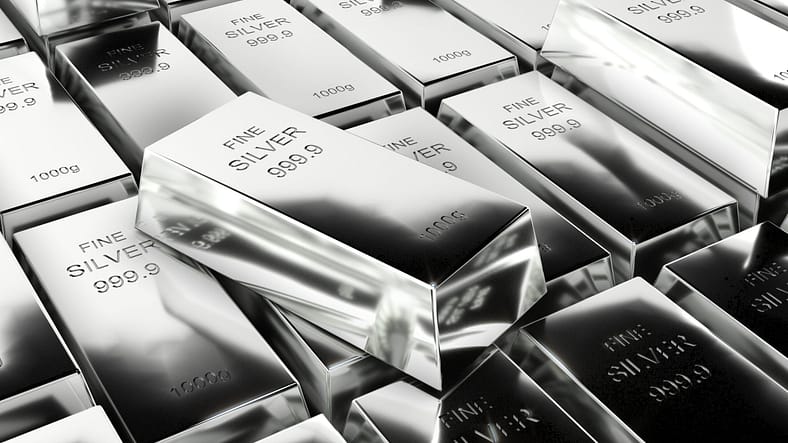What is the current price of silver today?
Silver’s price as of 9 a.m. ET was $30.81 per ounce. That’s down 0.56% from the previous day and up 28.75% since the beginning of the year.
The lowest price for the precious metal in the last 24 hours was $30.62 per ounce per ounce. The highest price in the past 24 hours: $30.99 per ounce.
Silver spot price
The spot price refers to the price at which silver can be bought or sold “on the spot,” or immediately. The futures price, however, reflects the price for silver delivered later.
Silver’s spot price in U.S. dollars is denoted as XAG/USD on the foreign exchange market. You can track silver’s spot price in other currencies, including XAG/GBP for British pounds and XAG/EUR for euros. Silver trades 24/7, so its price is always shifting.
Silver price chart
See the chart below for how silver spot prices have changed over the past year. The data is updated at 9 a.m. ET and doesn’t have intraday lows or highs.
As of 9 a.m., silver is up 28.75% since the beginning of the year. The 52-week high reached $32.51 on May 19, 2024, and the 52-week low dropped to $20.69 on Oct. 2, 2023.
The spot price of silver represents the current market rate at which silver can be exchanged and immediately delivered. Similar to gold, silver prices can be provided in troy ounces, grams and kilograms. Notably, a troy ounce, the standard unit for quoting silver prices, is slightly heavier than a standard ounce, with one troy ounce equaling 31.103 grams or 1.097 ounces.
The worldwide silver spot price calculation is a complex process, influenced by several factors and majorly impacted by futures contracts rather than physical silver trading.
Precious metals spot prices
You can trade four main precious metals via physical bullion, exchange-traded products or futures contracts. They are silver, gold, platinum and palladium. All trade 24/7 in various currencies.
Gold/silver ratio
The gold/silver ratio is the price of an ounce of gold divided by the price of silver per ounce. As of today, the gold/silver price ratio is 83.69.
The gold/silver ratio is significant because it is a tool for comparing the relative values of these two precious metals over time. This ratio helps investors and traders understand how the value of gold and silver fluctuates compared to each other.
The high ratio suggests that gold is more expensive than silver, indicating a market preference for gold as a haven, which can mean economic uncertainty. Conversely, a lower ratio implies that silver is gaining value or that gold is becoming less expensive.
This ratio can also indicate potential buying opportunities. For instance, if the ratio is historically high, some investors might see it as a cue to buy silver, expecting it to revert to a long-term average.
The gold/silver ratio is also used to gauge economic health. Shifts in the ratio reflect changes in market sentiment and economic conditions.
History of silver prices
Silver prices peaked in January 1980 at $49.45 per troy ounce. They hit a low of $3.56 per troy ounce in February 1993.
Silver’s spot price has fluctuated over the years. Variables like supply and demand, geopolitical events, currency strength, economic data, and changes in investment trends impact silver prices.
1970 – 2005
Silver was under $10 per ounce in the mid-1970s. It reached nearly $50 in 1980. But silver fell back under $10 by the late 1980s.
2006 – 2024
Silver prices cleared $10 again in 2006.
The Great Recession drove prices higher. In March 2008, spot prices reached about $20 per ounce. But another sharp decline followed. Silver dropped back below $10 by October 2008.
Another major jump occurred a few years later. In April 2011, silver traded at over $45 per ounce.
Silver future prices
Global exchanges exist in London, Hong Kong, Zurich, New York and Chicago. They allow for nearly 24-hour silver trading. The COMEX plays an essential role in setting silver spot prices. This branch of the Chicago Mercantile Exchange uses futures contracts to project silver prices.
Silver futures are contracts to buy or sell silver for a set price at a set future date.
Silver ETPs
Silver exchange-traded products have a variety of structures. These include closed-end funds and grantor trusts.
ETPs typically operate by holding silver bullion in audited storage locations. They trade like stocks on exchanges. Investors buy shares that represent fractional ownership of the stored silver. Note that management fees and other expenses can impact returns.
Investing in silver
There are three primary ways to invest in silver:
- Bullion.Directly owning physical silver is a simple way to invest. But you’ll need a place to store it. You’ll likely want insurance too. These costs can eat into your returns.
- Futures. Futures contracts are a popular way to speculate on silver prices. They also let you hedge against price movements. Note that futures can be risky, especially if you’re trading on margin.
- ETPs. ETPs are available in most brokerage accounts, making them accessible. Their downsides include potential management fees and tracking errors.
Is buying silver a good investment?
Various economic factors affect silver’s price movement. Your objectives, risk tolerance and time horizon also impact whether silver is a good investment.
Silver is one way to diversify a portfolio that includes stocks and bonds. But it can be volatile and risky. Consider your options before investing in silver.
Frequently asked questions (FAQs)
Silver’s highest historical price was $49.45 per ounce on Jan. 18, 1980.
Silver’s effectiveness as a hedge against inflation is mixed and varies by time and location. Some studies indicate that silver does not correlate well with consumer price movements in the U.S. But there has been some correlation in the U.K. market over the long run.
But for a more reliable hedge against inflation, investors might consider other commodities like energy and agricultural products. These often have a more direct and consistent relationship with inflationary trends.

